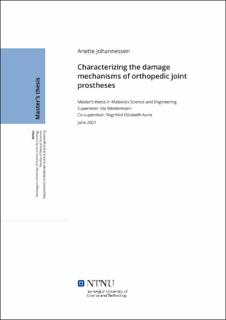| dc.contributor.advisor | Westermann, Ida | |
| dc.contributor.advisor | Aune, Ragnhild Elizabeth | |
| dc.contributor.author | Johannessen, Anette | |
| dc.date.accessioned | 2021-10-20T17:28:02Z | |
| dc.date.available | 2021-10-20T17:28:02Z | |
| dc.date.issued | 2021 | |
| dc.identifier | no.ntnu:inspera:80234703:25580704 | |
| dc.identifier.uri | https://hdl.handle.net/11250/2824267 | |
| dc.description.abstract | Dette prosjektet undersøkte tre brukte hofteleddsproteser med hensikt å forstå hvilke skademekanismer som var til stede og hvorfor disse oppsto. En rekke metallurgiske undersøkelser ble benyttet for å avdekke overflatekarakteristikk, mikrostruktur og materialegenskaper.
To av protesene besto av CoCrMo og refereres til som protese Co og protese Co-o. Den siste protesen besto av rustfritt stål og refereres til som protese SS. Protese Co-o hadde et utmattingsbrudd på stammen, forårsaket av syklisk belastning ved bruk. Protesen hadde ujevn overflate, hvilket ga mange punkter med økt spenning der sprekker kunne initiere, samt svært store korn som tillot rask sprekkutvikling. Protese Co hadde også uhensiktsmessig store korn. Protese SS hadde større korn i vinkelrett retning på protesens lengde enn parallelt. Dette var uheldig da typiske belastninger for en hofteprotese vil gi sprekkutvikling i den retningen hvor det er færre korngrenser som kan hindre dette. Alle protesene hadde misfarge og overflatelag som følge av korrosjon. Det hadde mest sannsynlig oppstått tribokorrosjon i overgangen mellom nakke og hode for protesene Co og Co-o. Alle protesene hadde større overflateskader som sannsynligvis ikke oppsto under bruk, men i etterkant. | |
| dc.description.abstract | This project investigated three used hip joint prostheses with the goal of understanding which damage mechanisms were present and why these arose. A series of metallurgical examinations were executed to reveal surface characteristics, microstructure and material properties.
Two of the prostheses were from a CoCrMo alloy and were referred to as prosthesis Co and prosthesis Co-o. The last prosthesis was made from stainless steel and was referred to as prosthesis SS. Prosthesis Co-o had a fatigue fracture at the stem, that originated from cyclic stresses during use. The prosthesis had an uneven surface, which provided many stress raisers where fatigue cracks could initiate, and very large grains that allowed crack propagation to develop rapidly. Prosthesis Co also had unfavourably large grains. Prosthesis SS had larger grains in the direction perpendicular to the stem length than in the parallel direction. This was unfavourable as the typical loads for a hip prosthesis would cause cracks to propagate in the direction in which there were fewer grain boundaries to impede them. All prostheses had discoloration and surface layers from corrosion. Tribocorrosion had likely happened in between the femoral heads and necks of prostheses Co and Co-o. All prostheses had larger damages to the surfaces that likely originated post use. | |
| dc.language | eng | |
| dc.publisher | NTNU | |
| dc.title | Characterizing the damage mechanisms of orthopedic joint prostheses | |
| dc.type | Master thesis | |
